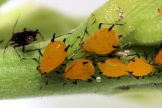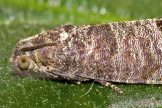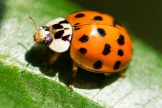
The Cabbage White Butterfly (Pieris rapae) and the Cabbage Moth (Plutella xylostella), along with their offspring (the very hungry caterpillars!) are responsible for the eaten leaves and irregular holes in the leaves of vegetables such as Cabbage, Cauliflower, Kale, Broccoli, Brussels Sprouts, Bok Choi, Wombok and Watercress.
The Cabbage White Butterfly (pictured here) is white with black spots on the wings. It is around 4cm across and has a Green-Blue caterpillar stage. The Cabbage Moth is greyish and small (around 1cm across) and has a Green-Brown caterpillar stage.

Both the butterfly and the moth lay their eggs on the underside of young leaves. The eggs develop into sap-sucking ‘crawlers’ that excrete a sugary honeydew. This then attracts black or green sooty mould on the surface of the leaf. The crawlers then turn into caterpillars and start chewing vigorously on your vegies!

What you can do:
- Pick off caterpillars by hand and run your fingers over the leaves to squash the eggs and crawlers.
- These guys are very territorial, so there are a few ways you can make it seem like another moth or butterfly is already in residence. Eggshell halves or the plastic clips from loaves of bread can be taped together to look a little like a butterfly and strung above your crops. You can even try hanging a few little fake plastic butterflies.
- Create a physical barrier by using exclusion netting (pictured here). Ideally you need to cover the entire bed for the whole growing season to stop the eggs being laid in the first place. Exclusion netting is available in the hardware section at BAAG.
- Spray with a Microbial Insecticide. Dipel is a very low toxic microbial insecticide that contains a bacteria which is highly effective and selective for caterpillars. It is a bacteria that occurs naturally in the soil and it acts as a stomach poison only to these caterpillars. It is totally safe to many beneficial insects, mammals, birds, fish and plants. There is no witholding period when harvesting crops that have been sprayed with Dipel (they can safely be eaten immediately). Dipel breaks down naturally in sunlight, so repeat sprays are necessary every 5-7 days.
Another good microbial insecticide is ‘Success’.





